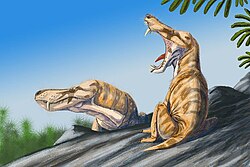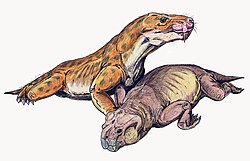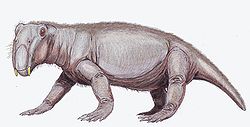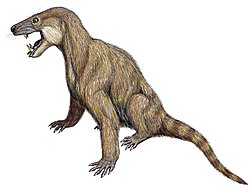Therapsid
Therapsids, previously known as the mammal-like reptiles,[2] are a group of synapsids.
| Therapsids | |
|---|---|

| |
| From top to bottom and left to right, several examples of non-mammalian therapsids: Biarmosuchus (Biarmosuchia), Moschops (Dinocephalia), Lystrosaurus (Anomodontia), Inostrancevia (Gorgonopsia), Glanosuchus (Therocephalia) and Chiniquodon (Cynodontia). | |
| Scientific classification | |
| Kingdom: | Animalia |
| Phylum: | Chordata |
| Clade: | Sphenacomorpha |
| Clade: | Sphenacodontia |
| Clade: | Sphenacodontoidea |
| Clade: | Therapsida Broom, 1905[1] |
| Clades | |
| |
The clade includes the mammals, which are descended from the cynodont therapsids.
Features
The jaws of therapsids had frontal incisors for nipping, large lateral canines for puncturing and tearing, and molars for shearing and tearing, and chopping food.
Therapsid legs were positioned more vertically beneath their bodies than were the sprawling legs of Sauropsids and Pelycosaurs.
Evolution
The therapsids were seriously affected by the P/Tr extinction event. The successful gorgonopsians died out, and the remaining groups were much reduced.
The dicynodonts were now a single family of large stocky herbivores, the Kannemeyeridae. The medium-sized cynodonts (including carnivorous and herbivorous forms), flourished worldwide in the early to middle Triassic. They died out across much of Pangea before the end of the Upper Triassic. Some survived for a while in the wet equatorial band and in the South.
At least three groups of eucynodonts survived. They appeared in the Upper Triassic. The extremely mammal-like family, the Tritylodonts, survived into the Lower Cretaceous. Another group, Morganucodon and its relatives, were mammaliaformes. That is, their descendants became the mammals.
Taxonomy
- Class Synapsida
- ORDER THERAPSIDA *
- Suborder Biarmosuchia *
- Suborder Dinocephalia
- Suborder Anomodontia *
- Superfamily Venyukoviamorpha
- Infraorder Dicynodonta
- (unranked) Theriodontia *
- Suborder Gorgonopsia
- Suborder Therocephalia
- Suborder Cynodontia *
- (unranked) Mammaliaformes *
- Class Mammalia
Therapsid Media
Illustration of Alopecognathus, an early therocephalian therapsid
Holotype skull of Raranimus dashankouensis, the most basal-known therapsid
Restoration of Euchambersia with dicynodont prey. Note that this South African therocephalian is suspected to be the oldest-known venomous tetrapod.
Reconstruction of Bonacynodon schultzi, a probainognathian cynodont related to the ancestors of mammals
Two genera of dinocephalians : Titanophoneus (an anteosaur) devouring a Ulemosaurus (a tapinocephalian)
Lystrosaurus, a dicynodont anomodont
Trucidocynodon, a non-mammalian cynodont
References
- ↑ Broom, R. (1905). "On the use of the term Anomodontia". Records of the Albany Museum. 1 (4): 266–269.
- ↑ They are not reptiles.
| Wikispecies has information on: Therapsida. |
- Kemp T.S. 2005. The origin and evolution of mammals. Oxford University Press
- Benton M.J. 2004. Vertebrate Paleontology. 3rd ed. Blackwell, Oxford.
- Carroll R.L. 1988 Vertebrate Paleontology & Evolution. Freeman N.Y.
- Romer A.S. 1966. Vertebrate Paleontology. 3rd ed, University of Chicago Press.









